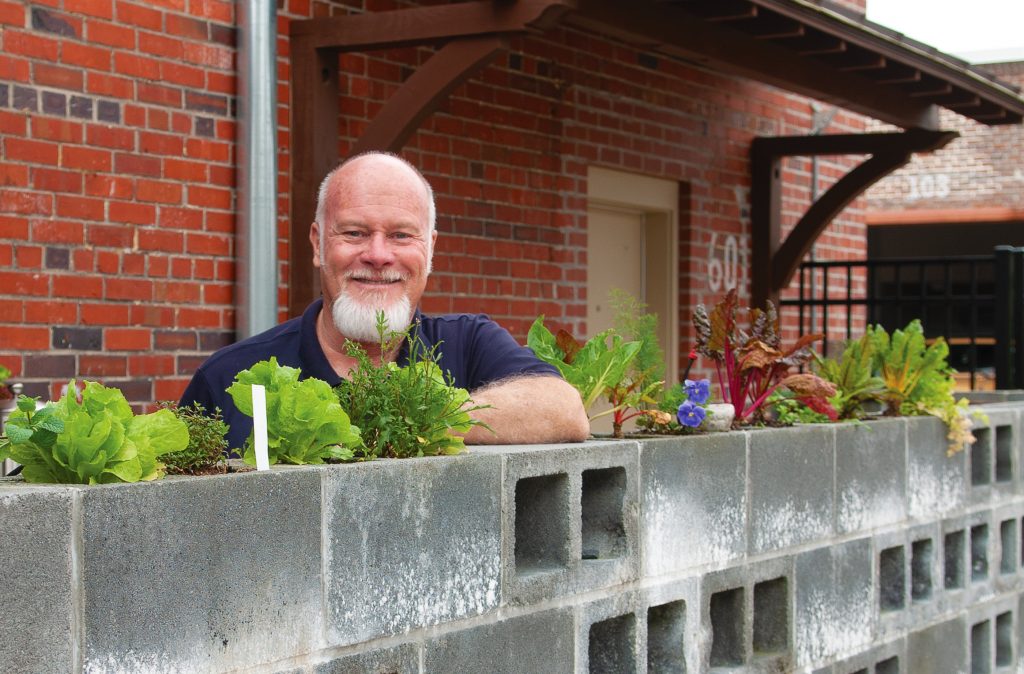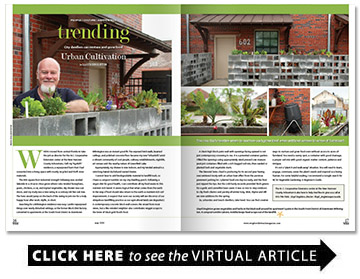Urban Cultivation
Find creative ways to nurture and grow food even without access to acres of farmland.
BY Lloyd Singleton

When I moved from central Florida to take the job as director for the N.C. Cooperative Extension center at the New Hanover County Arboretum, I left my “Agriloft” residence, a repurposed barn that I had converted into a living space with mostly recycled and thrift store materials.
The 800-square-foot industrial strength hideaway was nestled lakeside in a 20-acre citrus grove where I also tended honeybees, goats, chickens, a cat, and myriad vegetables. My shower was outdoors, and my study was a tree swing in a century-old live oak tree. The hens would jump on the back of the swing to join me for a truly happy hour after work. Idyllic, in short.
Searching for a Wilmington residence was easy. I prefer repurposed things over newly disturbed settings, so the former Block Shirt factory converted to apartments at the South Front District in downtown Wilmington was an instant good fit. The exposed brick walls, beamed ceilings, and polished concrete floor became my new “Urbanloft,” amid a vibrant community of cool people, culinary establishments, nightlife, art venues and the nearby nature of Greenfield Lake.
Appropriately, my shower is now indoors, and my tended animal is a mini long-haired dachshund named Dexter.
I cannot bear to add biodegradable material to landfill trash, so I have a compost tumbler on my city-dwelling porch. Following a vegan diet for good health, I can contribute all my food waste to this nutrient-rich barrel. It seems logical that what comes from the earth in the way of food should also return to the earth as nutrient-rich soil improvement. (I suspect that soon our society will see the error of our ubiquitous landfilling practice as our agricultural lands are degraded.) A contemporary concrete block wall screens the vessel from most views, but a like-minded neighbor also contributes veggie scraps to the brew of black gold food’s food.
A chest-high block patio wall with openings facing upward is not just contemporary screening to me. It is a potential container garden. I filled the openings using appropriately sized pressed cow manure peat pot containers filled with a rich bagged soil mix, then seeded or planted herb and vegetable starts.
The biennial Swiss chard is producing for its second year having over-wintered nicely with an urban heat effect from the pervious pavement parking lot. I planted basil one day too early, and the frost just nipped the tips. But the cold-hardy escarole provided fresh greens for a garlic and cannellini bean sauté. It was so nice to step outdoors to clip fresh cilantro and parsley all winter long. Mint, thyme and dill are new additions for the spring.
So, urbanites and beach dwellers, take heed. You can find creative ways to nurture and grow food even without access to acres of farmland. You need a sunny spot, a container with good drainage, a proper soil mix with good organic matter content, patience and intrigue.
It’s not a “plant it and walk away” situation. You will need to learn, engage, commune, sense the plant’s needs and respond as a loving human. For some helpful reading, I recommend a Google search for NCSU Vegetable Gardening: A Beginner’s Guide.
The N. C. Cooperative Extension center at the New Hanover County Arboretum is also here to help. Feel free to give us a call at 910-798-7660. Lloyd Singleton, director • lloyd_singleton@ncsu.edu

Thanks, Lloyd Singleton, for enlightening readers that growing food involves: “…..a sunny spot, container with good drainage, a proper soil mixed with good organic matter content, patience, and intrigue.”